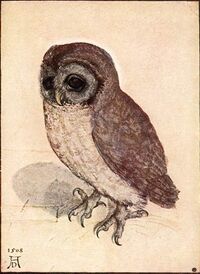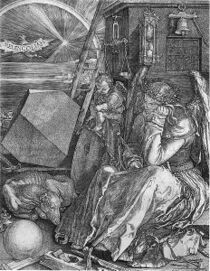Albrecht Dürer

Albrecht Dürer (May 21, 1471 – April 6, 1528) was a Renaissance painter, printmaker and self-declared Second Coming of Christ. Born in Nuremberg, Germany, he made it his mission, throughout his career, to convince the German people of his divine superiority through his chosen medium, the pictorial arts. Unfortunately, noone has actually heard of him aside from the most ardent of arts' afficianados, but they assured us of this, just as they assure us that his mastery of draughtsmanship is "beyond perfection, my dear" and say his contributions to the naturalistic style - employing a "quite exquisite" earthy pallette - are second only to Leonardo da Vinci to none.
When asked specifically about his works, academic types generally maintain that he is best known for his series of self-portraits - both engraved and painted - in which he bears an uncanny (but quite deliberate) resemblance to Jesus Christ ("but far more handsome..."), a series of naturalistic sketches made while travelling in the Netherlands and a number of later religious devotional works ("devoted to himself, of course.").
I will now recount the artist's life, with assistance on technical and aesthetic matters coming from the esteemed Professor Stefan Knapp from Vienna's Kunsthistorisches Museum.
Youth[edit]

Supposedly born of a virgin birth in his native Germany, the young Dürer was massively obsessed with his greatness from day one. While on vacation in Flanders in 1479, his father - a successful goldsmith with strong links to Flemish arts circles - took him to see the works of the Flemish master Jan van Eyck. It was upon viewing of a particularly ground-breaking "Madonna and Child", that Young Albrecht decided he knew what he wanted to do with his life. He was captivated and awe-inspired by the majestic work, he had seen something in the picture that no art afficianado before him had seen - how much the baby looked like him!
As soon as he returned to Nuremberg, he embarked on a series of promising sketched studies and potato prints in an attempt to realise his dream. His parents, noting his interest in art and deciding he needed guidance, sent him to work with his godfather, a renowned printer. He worked as his godfather's understudy for a number of years, which naturally frustrated the great artist. It is fortunate, but not at all unexpected, that Dürer left many autobiographical writings that document this phase in his life:
Albrecht Dürer's Diary - TUESDAY JUNE 17th 1489
- Again, dear diary, I come to thee in quite the disagreeable mood. Yet another desparate day I have spent suffering in the shadow of my talentless oaf of a teacher. The arrogant fool belittles my contributions to the workshop on a daily basis, even though the obnoxious Walloon can't even paint a donkey without the aid of a picture book. My father has forsaken me for so many moons that I have even gone so far as to question whether he is worthy of such prestigious a title. The good news is that the landlady's daughter, Beatrice (who is the very personification of exquisite beauty and not at all like the other repugnant sour Krauts), has - I believe - taken a fancy to me. I have been slipping some of my studies under her door at night - majestic eagles, noble visages, some anatomical studies, ethereal landscapes - in the confidence that she will recognise my genius and we can elope at once to Salzburg. She smiles back at me as I pass her window every morning, I think that on Friday I will ask her to model for me - I am in love.
The contents of this diary, when cross-referenced with that of Beatrice's, make for interesting reading:
Beatrice von Schnitzelsteiger - WEDNESDAY JUNE 25th 1489
- Dear diary, allow me to be frank for once, away with the polite demeanor through which I feel inclined to address the world on a daily basis. My prudence is being tested by...
First Call to Prophethood[edit]

Dürer's breakthrough evenutally came during his Wanderjahren (wander years). Following the end of his spell with his godfather, Dürer embarked on a trip to The Netherlands - home of the Northern Renaissance - and Italy - home of the actual Renaissance. Here he painted the first known natural landscape studies in European art, because he could, before travelling to do further studies in Venice. It was here in this busy Mediterranean trading centre that Dürer first experienced and expressed his true calling.
Adulthood[edit]
Upon his return from Italy, Dürer painted another couple of self-portraits before marrying Agnes and opening up his first workshop (marriage, interestingly, was a prerequisite for this). According to his wife's diary, Albrecht spent most of his days with "his bunnies", sketching them over and over again. Showing concern that he was spending the majority of his time with the tiny mammals, grooming, posing and sketching them, Agnes suggested he turn his attention elsewhere. So he did, and the world was graced by a further four self-portraits, a series of charcoal studies dedicated to the perfection of the artist's nose, and an (ultimately rejected) altarpiece for Aachen Cathedral in which the similarity of appearance between Albrecht and the subject was no longer subtle by any stretch of the imagination.
Unsurprisingly dejected and in a state of despair at this oversight on the part of the Church elders, Dürer immediately sought a scapegoat for his misfortune. Since the Jews were, at the time, pretty unpopular with the same people with whom Albrecht had himself been the subject of rejection, he - after a brief period flirting with Kabbalah, which soon ended when he realised he could no longer eat pork - decided to exact revenge on the woman whose tactless demands had brought him to such a sorry state. Fortunately for him, he chose the right time to do it, since Adam and Eve paintings had become all the rage among the affluent arts connoisseurs and Albrecht could both vent misogynist spleen and earn enough bucks for another amble to the other side of the Alps for more inspiration. His diary entry for 7 July 1499 can shed further light:

Second Call to Prophethood[edit]
Dürer's second brush with Greatness (and no, I don't mean that laudanum fiend Hieronymus Bosch), came just before his 30th birthday. By this time, Dürer's reputation as an animal portrait artist had grown to the point that royalty from throughout Europe were commissioning him portraits of their kittens, rhinos and stick insects, and the artist's living had become reasonably comfortable. His most consistent patron was the then Holy Roman Emperor, Maximilian I, who funded numerous projects for Dürer and provided him with lodgings in a building large enough that he could avoid all contact with Agnes, sometimes for weeks on end. Here Dürer painted Maximilian, Maximilian's horse, Maximilian beside Maximilian's horse, Maximilian riding Maximilian's horse, and Maximilian riding Maximilian's horse. Though the veracity of the latter cannot be determined, Maximilian was a Hapsburg after all, so it's really not too far fetched.
Dürer's reputation not just in regal circles, but also amongst the intellectual elite, had begun to grow and during this time he sketched, engraved, painted, oiled and tattooed such luminary figures as the Dutch humanist Erasmus, the German painter Michael Wolgemut, the French noble Henri le Trescontraire, and the Spanish Belgian Waffle entrepeneur, Manuel Quinda-Bueno. It was also in this time that Dürer first made contact with the Reformation Movement and its pioneers, notably Martin Luther, about whom more later, before travelling south again. Once again, in Italy, where such things were encouraged rather than frowned upon, Dürer's fascination with himself could once again blossom. Dürer's second prophetic vision called him to meet the challenge of his Italian Renaissance contemporaries.
Rivalry with Da Vinci[edit]
Dürer's sight being set on wrestling the reputation of the era away from his effeminate contemporaries, he immediately locked himself away in his studio to devote his time solely to this most precious of tasks.
 The rivalry was intense and obsessive. For example, when Dürer sent Leo this immaculate sketch of two hands joined in the pious act of prayer ... |
 ...the wily Italian would reply with his own set of faultless hands telling Dürer exactly what he thought of him! Needless to say, the oversensitive Dürer did not react well to this |
Evaluation[edit]
Unlike other Northern European artists of the period, who were quite content just painting triptychs for altarpieces or getting stoned out of their mind and painting triptychs for altarpieces, Dürer choose to demonstrate his genius by mastering every type of artistic endeavour know to man. Dürer painted anything and everything. Just to prove he could.
Dürer worked in a pet store to support his artistic pursuits. Watch Dürer sell bunnies! *Sigh*
A rhinoceros! How exotic! Leo never painted one of these did he? HA! Amateur!
Painted around the time of his first visions, Dürer made sketch-after-sketch of this grass, usually gawping in awe and wonder.
Dürer's flattering depiction of his beloved mother (possibly proof the virgin claims were true).
Dürer was a keen supporter of the Lutheran movement until he realised the focus of worship was still the same boring Jesus.








